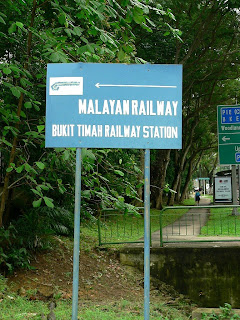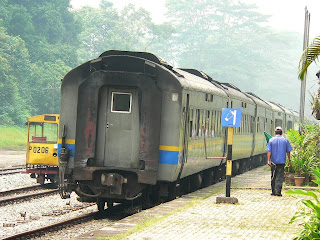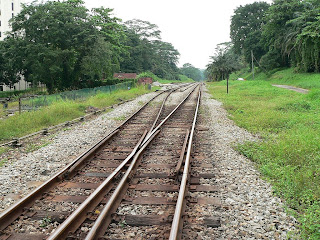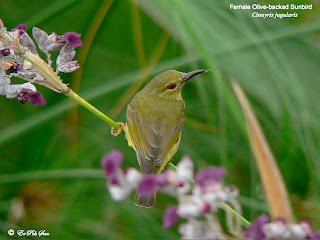History has forgotten about Bukit Timah railway station. Constructed between 1900 and 1902, it was opened in 1915 as part of the Singapore-Kranji Railway.
Today, Bukit Timah Railway Station is just a passing loop railway station used for train crossings and there are no longer boarding/alighting of passengers or collection of cargo.
 Click on the above photo for high-res image
Click on the above photo for high-res image Directional sign pointing the way to the Railway Station, in case you forgot to bring along your GPS.
 Click on the above photo for high-res imageJust to remind you that you are standing on KTMB property.
Click on the above photo for high-res imageJust to remind you that you are standing on KTMB property. Click on the above photo for high-res image
Click on the above photo for high-res imageThe signbnoard tells passengers that they have reached Bukit Timah. For south bound trains, the next station is "Singapura" (Tanjong Pagar). North bound would be Woodlands.
 Click on the above photo for high-res image
Click on the above photo for high-res imageThe Bukit Timah Railway Station was once a place where trains used to stop for passengers to board or alight. After the Malaysian Immigration decided to move to Tanjong Pagar station, the Bukit Timah station now serves as an interchange for trains that are meant to cross with each other. Besides this function, it also carries out an interesting daily routine which is the exchange of "key tokens", a traffic management system to prevent collisions on single-track lines.
There are three lines at the station. The first, nearest to the station platform is the mainline. The middle line is called the loop line and is used to keep a train waiting for a crossing. Crossing means two trains crosses with each other at the station. One of the trains will proceed into the loop line and wait till the train occupying the main line is cleared. The last line is for emergency purposes such as to keep defective wagons or to unload cargo.
 Click on the above photo for high-res image(KTMB) Trolley P0206 passing by Bukit Timah Railway Station
Click on the above photo for high-res image(KTMB) Trolley P0206 passing by Bukit Timah Railway Station Click on the above photo for high-res image
Click on the above photo for high-res imageA south bound train slows down for the "key token" passing ritual as it approaches Bukit Timah Station. The engine driver would place the "key token" on to a pole for the Station Master to pick it up. In return, he will be given a new "key token" before proceeding to the next station.
Gaining the "key token" signifies permission to proceed, based on security and traffic conditions.
 Click on the above photo for high-res image
Click on the above photo for high-res imageHaving collected the "key token", the Station Master returns to his office.
 Click on the above photo for high-res imageA railroad switch.
Click on the above photo for high-res imageA railroad switch. Click on the above photo for high-res imageThe truss bridge across Bukit Timah Road
Click on the above photo for high-res imageThe truss bridge across Bukit Timah Road Click on the above photo for high-res image
Click on the above photo for high-res image Click on the above photo for high-res image
Click on the above photo for high-res image Click on the above photo for high-res image
Click on the above photo for high-res image Click on the above photo for high-res image
Click on the above photo for high-res imageIn Singapore, Keretapi Tanah Melayu Berhad (KTMB) operates the narrow "metre gauge" tracks (1000mm).






















































